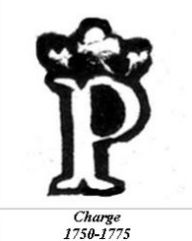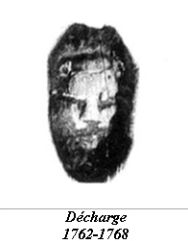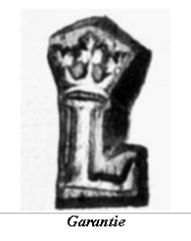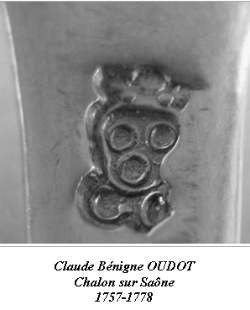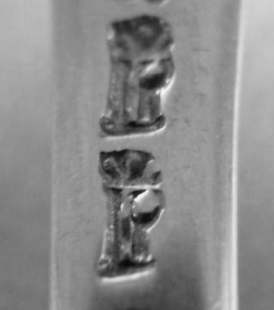by
Christophe Ginter
(click on photos to enlarge image)
Fraud on silver taxes during the French Royalty
Chalon sur Saône (France) 1762-1768
During a recent review of a private collector, regarding a table service, I discovered
an exceptional silver item bearing faked hallmarks struck by the maker himself in
order to escape silver taxes and warranty payments.
In spite of its false marks, the fork, which is made of plain silver (a model called
"uniplat") may be dated 1762-1768 and was produced in the Burgundian town of Chalon-sur-Saône.
During that time, the town of Chalon belonged to the Bourgogne (Burgundy) region whose capital
is DIJON. Chalon is located ca. 130 kilometres to the north of LYON.
During the eighteenth century, there were usually six silver workshops in Chalon.
|
 |
This article is exploring the legal rules surrounding silver hall-marks during the reign of
Louis XV and the way used by the silversmith to cheat them.
LEGAL HALLMARK STRIKING ("INSCULPATION") DURING THE REIGN OF LOUIS XV
As from 1672, silver and golden items are supporting taxes. The silver tax is called the "Droit
de Marque" and is due in most of the parts of the French kingdom. Tax collectors (the
"fermiers généraux") benefit from a fee set up by the royal authority (they may be
silver makers themselves). The tax rights are attested on silver by two marks that are struck at
different moments:
- the Charge mark, that may be considered as some kind of a tax declaration, is struck on the item that
is still in a sketch state. The punch is "charging" the item, i.e. the silver maker is
hence committed to re-present the piece when it will be finished and ready to be sold, and pay silver
taxes,
- the Discharge mark is struck on the finished item, confirming this payment, hence "discharging"
the item from any further tax submission.
Furthermore, makers are compulsorily required to let their own guilds test the purity of
silver and pay a fee for this assay. The latter is organized by elected silversmiths that are
for some time the wards ("Gardes") allowing allowed to strike a Warranty mark.
To summarize, one may find on French silver items 4 marks that are stamped chronologically in the
following order: the maker’s mark in first place, together with the Charge, then the Warranty, and
the Discharge completing the hallmarking procedure.
The town of Chalon-sur-Saône in Burgundy is committed to follow such rules. Charge and Discharge
marks are commonly employed from the end of the seventeenth century. The Warranty mark has
the shape of a capital letter, crowned, and is regularly modified when new wards are elected.
THE LEGAL (AUTHENTIC) MARKS IN CHALON-SUR-SAONE DURING THE 1762-1768 PERIOD
At the time the fork is sold to its final customer, the official marks to be stamped on silver
items are as follows:
- the Charge Mark has not been changed from 1750 to 1775, it should be the letter P under an
open crown bearing flowers ("fleurons"),
- the Discharge Mark registered between 1762 and 1768 appears to be a feline head (please note that
discharge marks are never crowned),
- the Warranty Mark terminates the legal procedure. The mark is a crowned date-letter that is
changed each year. The model shown above (with L) is used in 1764. The attached crown is open,
bearing flowers ("fleurons")
THE PROBABLE REASONS FOR CHEATING SILVER TAXES AND WARRANTY FEES
At the time the fork is sold, the long reign of King Louis XV (who dies in 1774) is finishing in
a very bad state. The poor state of the economy is pushing the authorities to drastically increase
taxes in the whole kingdom. Including fees for the warranty issue, all taxes may account for about
half the price paid to the makers by their own customers!!
A huge cost that may explain why silversmiths are trying to cheat on these taxes.
THE FORK AND ITS FALSE (FAKED) MARKS
The fork is in plain silver, there are no armorials engraved on the spatula. There
is no monogram either. Its teeth are in very good state, still very sharp ones.
This item is twenty centimetres long, its weight 73 grams.
I am showing below the different marks stamped in their order displayed on the handle.
The marks are still in a very good state, neither damaged nor erased.
|
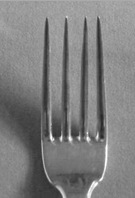 |
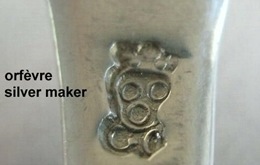 |
Here is the genuine maker’s mark of Claude Bénigne OUDOT
The stamp is showing: the letters C and O (a point in between) that are his initials, under
the crowned armorial bearings of Chalon containing three little rings.
This silversmith was registered in Chalon in 1757, his activity was pursued until 1778.
|
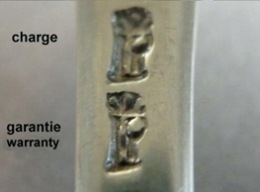 |
Here is the first faked mark,
An antique crowned P imitating the authentic stamp.
Then, a second false mark,
The same antique P that is cheating the genuine warranty mark.
|
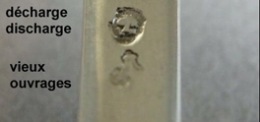 |
Last, but not least, a feline head that is astonishingly imitating the authentic
discharge mark. The third false mark.
The fork was later stamped with a mark called « Old Works » ("vieux ouvrages")
between 1781 and 1789 (an authentic mark meaning that the item has been resold).
|
Without taking into account this last mark, one may summarize the way used by Mr OUDOT for
cheating the law:
- first of all, Mr OUDOT knows that is would be necessary to strike four marks on the fork,
as any item in conformity with the legal procedure,
- second, he produces a crowned P that is a good reminder of what the charge mark should be,
the antique aspect of this letter is a valuable trick,
- he feels confident that the same antique P will be confused with a normal warranty mark, hence
taking some risks of being caught up (an event that never occurred!),
- finally, Claude OUDOT creates his own discharge mark that is remarkably imitating the official
one (feline head) used between 1762 and 1768 in Chalon. Please note that this mark hence allows
giving a precise dating of this fraud.
It seems that Mr OUDOT does not fear the numerous punishments attached with cheating the hallmarking
system (being excluded from the corporation, ban or even death sentence).
It seems that such a fraud was never discovered, as the track records of Claude OUDOT are showing
no suit, the silversmith is pursuing his activity until 1778. One may guess that his customer
maybe took part in this cheating....
BIBLIOGRAPHY
This fraud has been duly recorded and precisely described in a reference book that is part of
the Cahiers du Patrimoine, n° 56, called "Les orfèvres de Bourgogne" (under the
supervision of the Ministère de la Culture, 1999, ISBN 2-85822-272-X), pages 20 and 21.
There is no doubt that such an item, in such a remarkable state, is a masterpiece in any
private collection. A happy few.
|
|
 ASSOCIATION OF SMALL COLLECTORS OF ANTIQUE SILVER
ASSOCIATION OF SMALL COLLECTORS OF ANTIQUE SILVER

